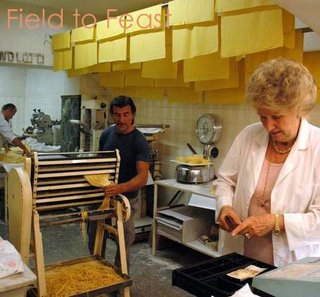 Coliseum? Check. St. Peter’s Basilica? Check. Sistine Chapel? Check. Roman Forum? Check. During our trip to Rome, Mark and I even, by sheer coincidence, found ourselves standing four feet from the Pope. Mamma mia!
Coliseum? Check. St. Peter’s Basilica? Check. Sistine Chapel? Check. Roman Forum? Check. During our trip to Rome, Mark and I even, by sheer coincidence, found ourselves standing four feet from the Pope. Mamma mia!
The mental postcards I took away from Rome, however, are not only images of its ancient sites and famous residents, but of its everyday people and everyday food. We will remember Osteria Antichi Saporo da Leo for 1) bruschetta con fagioli (a crusty slice of bread adorned with creamy white beans and doused in a fruity olive oil), 2) schiaffoni alla ricotta forte pugliese (rough-cut pasta tubes tossed in a tomato sauce made with an uncommonly pungent ricotta cheese), 3) radicchio con provola affumicata alla griglia (mounds of grilled radicchio capped by disks of provolone cheese, all well-moistened by a lemon-pepper vinaigrette) and 4) Leo, the proprietor. Pleased that we had just concluded our second meal at his establishment, Leo pointed to our empty glasses of raisin-soaked grappa and proclaimed – hands gesturing from his heart – “Free-o.” “Grazie, grazie,” we happily replied. With a flourish, he grabbed our glasses and gave us a refill of this traditional after-dinner liqueur, also “free-o.” Grappling not-too-successfully with my double-dose of grappa, I practically burst into tears as we said arrivederchi.
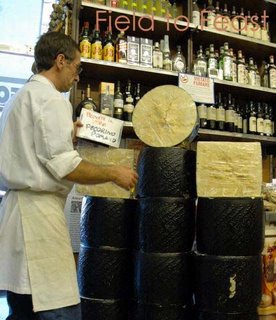 Another proprietor, another day. At Antica Caciara Trasteverina, Roberto proudly shaved off a paper-thin slice of his pecorino Romano for me to sample. I closed my eyes as it dissolved on my tongue, not wanting to hurry the experience by chewing. We purchased a wedge and asked if we could take a photo of his store. He said yes, and began carefully arranging his wheels of cheese to show off their best sides. (He apologized for stepping into our picture. We wanted him there all along.)
Another proprietor, another day. At Antica Caciara Trasteverina, Roberto proudly shaved off a paper-thin slice of his pecorino Romano for me to sample. I closed my eyes as it dissolved on my tongue, not wanting to hurry the experience by chewing. We purchased a wedge and asked if we could take a photo of his store. He said yes, and began carefully arranging his wheels of cheese to show off their best sides. (He apologized for stepping into our picture. We wanted him there all along.)
In Rome, foodie heaven is a neighborhood gastronomia like Antica Caciara Trasteverina. Cured meats hang from hooks in the ceiling, hand-scrawled labels identify a huge variety of cheeses and salamis, and shelves labor under bowls of pesto and submerged buffalo mozzarella. The walls are lined with row upon row of Italian olive oils and Italian wines, some graced with the distinctive black rooster seal which means that the Chianti Classico you are holding actually comes from Chianti. Seduced by a sample at a gastronomia called Volpetti, we bought dried Calabrian figs and pecorino di Fossa, a cheese that is wrapped in a cloth sack, placed on a bed of burnt straw in an underground hole, covered with sand and pebbles, and aged for 100 days.

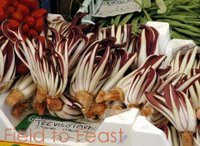 Overflowing fruit and veggie markets and sweet-smelling pasticcerias are also stellar spots for open-jawed food gazing and selective taste-testing. At Campo de’Fiori, stare-worthy vegetables included fresh borlotti beans in their mottled rose-colored shells, heads of cauliflower Romano with their eye-catching hue (chartreuse) and texture (imagine 3-D ice crystals),
Overflowing fruit and veggie markets and sweet-smelling pasticcerias are also stellar spots for open-jawed food gazing and selective taste-testing. At Campo de’Fiori, stare-worthy vegetables included fresh borlotti beans in their mottled rose-colored shells, heads of cauliflower Romano with their eye-catching hue (chartreuse) and texture (imagine 3-D ice crystals),  radicchio rosso di Treviso (a chicory variety that looks like white-flamed torches with burgundy tips), and tiny, unidentified berries, which glowed a luminescent red and tasted like cherry-infused strawberries. Meanwhile, the bountiful display cases at each pasticceria we visited made choosing an accompaniment to our espresso difficult – that is, until we discovered pinolate, a marzipan ball rolled in pine nuts, which we proceeded to seek out wherever we went.
radicchio rosso di Treviso (a chicory variety that looks like white-flamed torches with burgundy tips), and tiny, unidentified berries, which glowed a luminescent red and tasted like cherry-infused strawberries. Meanwhile, the bountiful display cases at each pasticceria we visited made choosing an accompaniment to our espresso difficult – that is, until we discovered pinolate, a marzipan ball rolled in pine nuts, which we proceeded to seek out wherever we went.
What amazed me most about food in Rome was first, how ingredients so simple could become dishes so extraordinary and second, why the heck I hadn’t heard of some of these dishes before. Take cacio e pepe, for example – pasta with a sauce made from Pecorino Romano, tons of ground black pepper, olive oil and, I suspect/fear, a healthy pour of cream. 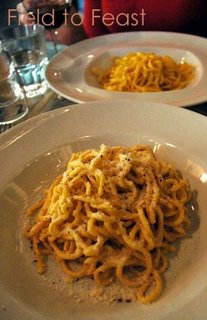 The pepper taste is quite powerful, and lingers in your mouth after every bite. At Alle Fratte di Trastevere the sauce was plentiful – almost like a peppery alfredo – and served with orecchiette, while at Antico Forno Roscioli it clung tightly to homemade spaghetti strands. A salad eaten on the piazza outside Osteria dell’Ingegno was notable for the phenomenal tenderness of its arugula, which was well-complimented by shaved parmesan, walnuts, halved cherry tomatoes, mushrooms and a light vinaigrette. The delicately battered and fried fresh anchovies (alici fritte) at Da Franco ar Vicoletto were juicy, meaty, and perfected by a squeeze of lemon juice. And the risotto of saffron and pistachios at Osteria Margutta was so rich that it was best eaten in tiny spoonfuls.
The pepper taste is quite powerful, and lingers in your mouth after every bite. At Alle Fratte di Trastevere the sauce was plentiful – almost like a peppery alfredo – and served with orecchiette, while at Antico Forno Roscioli it clung tightly to homemade spaghetti strands. A salad eaten on the piazza outside Osteria dell’Ingegno was notable for the phenomenal tenderness of its arugula, which was well-complimented by shaved parmesan, walnuts, halved cherry tomatoes, mushrooms and a light vinaigrette. The delicately battered and fried fresh anchovies (alici fritte) at Da Franco ar Vicoletto were juicy, meaty, and perfected by a squeeze of lemon juice. And the risotto of saffron and pistachios at Osteria Margutta was so rich that it was best eaten in tiny spoonfuls.
Can anyone talk of food in Italy without mentioning pizza and gelato? You cannot. The pizza in Rome is thin crust and comes in red (with sauce) and white (no sauce) varieties. Pizzaiole apply toppings with a light touch and do not disturb their masterpieces by slicing – you and you friends must admire their handiwork then tear off your own delectable, odd-shaped pieces. We particularly enjoyed one pie topped with tuna, capers and olives and another decorated with anchovies and curls of puntarelle, another type of chicory. After your pizza, the crème de la crème of gelato has to be the licorice version at San Crispino, which is served with a slather of dense whipped cream. Alternatively, you could try gelato’s cream-topped brethren, granita de caffe, which we found at Maestri Gelatieri di Calabria. This grated ice and coffee combo is perfect for when you want to experience your after-dinner coffee and dessert in one potent dose.
In a six-day trip, you can only eat and drink so much. Luckily, we brought some of Rome home – the aforementioned pecorino Romano, pecorino di Fossa, and dried figs, along with Arborio rice, polenta mix, a massive wedge of Parmesan, and a package of multi-colored estratterrestri, a shell-shaped pasta bought at a pasta-making stop called Pastificio that featured myriad pasta shapes, some stunningly striped like ribbon candy. But, despite our copious eating and load of take-home goodies, here, in no particular order, are foods I missed out on – otherwise known as reasons I must return to Rome:
Baccalà (salted cod)
Cavolo nero (a black cabbage traditionally used to make ribollita)
Arancini and suppli (fried rice ball snacks)
Carciofo alla giudia (deep-fried artichoke)
Carciofo alla Romana (artichoke stuffed with mint or parsley and garlic)
Baba (a rum-soaked yeast bun)
Heading to Rome sometime soon? Lucky you! Listed below are the addresses of the shops and restaurants noted above. Mangia! Mangia! And beware of grappa refills.
Alle Fratte di Trastevere
Via delle Fratte di Trastevere 49/50, Trastevere
Antica Caciara Trasteverina
Via S. Francesco a Ripa 140, Trastevere
Antico Forno Roscioli
Via dei Giubbonaro 21-22, South of Campo de’Fiori
Da Franco ar Vicoletto
Via dei Falisci 2, San Lorenzo
Maestri Gelatieri di Calabria
Via Marmorata 111, Testaccio
Pastificio
Via della Croce 8
Osteria Antichi Saporo da Leo
Via Aurelia 366
Osteria dell’Ingegno
Piazza di Pietra 45
Osteria Margutta
Via Margutta 82
San Crispino
Via della Panetteria 42
Volpetti
Via Marmorata 47, Testaccio
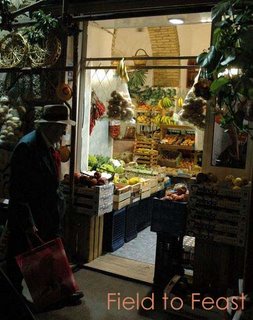 Note: Many thanks to new mom Gia at Gia-Gina in Italy for all her eating tips!
Note: Many thanks to new mom Gia at Gia-Gina in Italy for all her eating tips!
 Coliseum? Check. St. Peter’s Basilica? Check. Sistine Chapel? Check. Roman Forum? Check. During our trip to
Coliseum? Check. St. Peter’s Basilica? Check. Sistine Chapel? Check. Roman Forum? Check. During our trip to  Another proprietor, another day. At Antica Caciara Trasteverina, Roberto proudly shaved off a paper-thin slice of his pecorino Romano for me to sample. I closed my eyes as it dissolved on my tongue, not wanting to hurry the experience by chewing. We purchased a wedge and asked if we could take a photo of his store. He said yes, and began carefully arranging his wheels of cheese to show off their best sides. (He apologized for stepping into our picture. We wanted him there all along.)
Another proprietor, another day. At Antica Caciara Trasteverina, Roberto proudly shaved off a paper-thin slice of his pecorino Romano for me to sample. I closed my eyes as it dissolved on my tongue, not wanting to hurry the experience by chewing. We purchased a wedge and asked if we could take a photo of his store. He said yes, and began carefully arranging his wheels of cheese to show off their best sides. (He apologized for stepping into our picture. We wanted him there all along.) Overflowing fruit and veggie markets and sweet-smelling pasticcerias are also stellar spots for open-jawed food gazing and selective taste-testing. At Campo de’Fiori, stare-worthy vegetables included fresh borlotti beans in their mottled rose-colored shells, heads of cauliflower Romano with their eye-catching hue (chartreuse) and texture (imagine 3-D ice crystals),
Overflowing fruit and veggie markets and sweet-smelling pasticcerias are also stellar spots for open-jawed food gazing and selective taste-testing. At Campo de’Fiori, stare-worthy vegetables included fresh borlotti beans in their mottled rose-colored shells, heads of cauliflower Romano with their eye-catching hue (chartreuse) and texture (imagine 3-D ice crystals),  radicchio rosso di Treviso (a chicory variety that looks like white-flamed torches with burgundy tips), and tiny, unidentified berries, which glowed a luminescent red and tasted like cherry-infused strawberries. Meanwhile, the bountiful display cases at each pasticceria we visited made choosing an accompaniment to our espresso difficult – that is, until we discovered pinolate, a marzipan ball rolled in pine nuts, which we proceeded to seek out wherever we went.
radicchio rosso di Treviso (a chicory variety that looks like white-flamed torches with burgundy tips), and tiny, unidentified berries, which glowed a luminescent red and tasted like cherry-infused strawberries. Meanwhile, the bountiful display cases at each pasticceria we visited made choosing an accompaniment to our espresso difficult – that is, until we discovered pinolate, a marzipan ball rolled in pine nuts, which we proceeded to seek out wherever we went.  The pepper taste is quite powerful, and lingers in your mouth after every bite. At Alle Fratte di Trastevere the sauce was plentiful – almost like a peppery alfredo – and served with orecchiette, while at Antico Forno Roscioli it clung tightly to homemade spaghetti strands. A salad eaten on the piazza outside Osteria dell’Ingegno was notable for the phenomenal tenderness of its arugula, which was well-complimented by shaved parmesan, walnuts, halved cherry tomatoes, mushrooms and a light vinaigrette. The delicately battered and fried fresh anchovies (alici fritte) at Da Franco ar Vicoletto were juicy, meaty, and perfected by a squeeze of lemon juice. And the risotto of saffron and pistachios at Osteria Margutta was so rich that it was best eaten in tiny spoonfuls.
The pepper taste is quite powerful, and lingers in your mouth after every bite. At Alle Fratte di Trastevere the sauce was plentiful – almost like a peppery alfredo – and served with orecchiette, while at Antico Forno Roscioli it clung tightly to homemade spaghetti strands. A salad eaten on the piazza outside Osteria dell’Ingegno was notable for the phenomenal tenderness of its arugula, which was well-complimented by shaved parmesan, walnuts, halved cherry tomatoes, mushrooms and a light vinaigrette. The delicately battered and fried fresh anchovies (alici fritte) at Da Franco ar Vicoletto were juicy, meaty, and perfected by a squeeze of lemon juice. And the risotto of saffron and pistachios at Osteria Margutta was so rich that it was best eaten in tiny spoonfuls. Note: Many thanks to new mom Gia at Gia-Gina in Italy for all her eating tips!
Note: Many thanks to new mom Gia at Gia-Gina in Italy for all her eating tips!






6 comments:
wow...what a delightful sounding trip. All the cheeses...yum.
Oh yum. And you are a fantastic writer, too. Yep, yep.
sounds like you had a wonderful time. i'm so pleased.
when i was 15 my parents took me to rome on a holiday. i fell in love immediately and returned when i was 18. i lived there, with an italian family, for 7 months and what surprised me was that (despite all the cioccolate calde, ciambelle, parmigiano and at least 2 gelati a day) i didn't put on any weight. fantastic!
i was going to blog my own "food lover's guide to rome" one day, but i think you've covered it off perfectly!
Hi Erin and Maryam,
Glad you liked the post! I now have to figure out a good time to eat those yummy cheeses I brought home. I always have this trouble when there is something special in my fridge or cupboard - I want to start eating the item, but don't want it to be gone!
Hi Anna,
You are so lucky! Not only for spending seven months in rome, but also for not gaining any weight! I must have gained about two kilos during our six days, so i'm afraid the Roman diet might not work for me. I was actually amazed that people there could keep so thin, especially with the size of pasta servings. I was expecting demure little scoops - not overflowing platefuls! There must be some secret....
And, please do write your Rome food guide, too! There are definitely enough wonderful spots for a many a post.
Best wishes,
Carolyn
wow, that's so lovely. i spent six days in rome and can't wait to return. you're absolutely right about the place and its food.
I don't know if you'll see this, since it's such an old post (I'm reading your archive backwards), but I'm pretty sure those red berries are redcurrants (http://en.wikipedia.org/wiki/Redcurrant).
Post a Comment